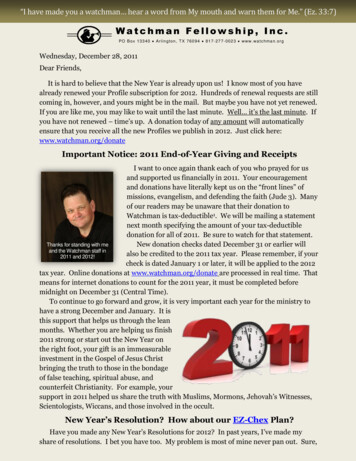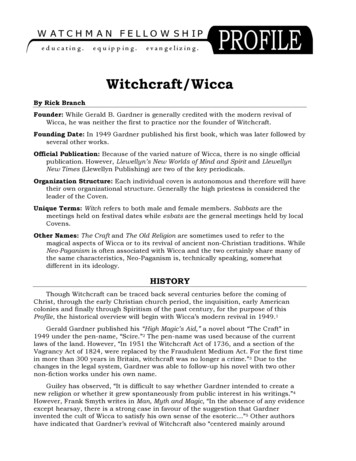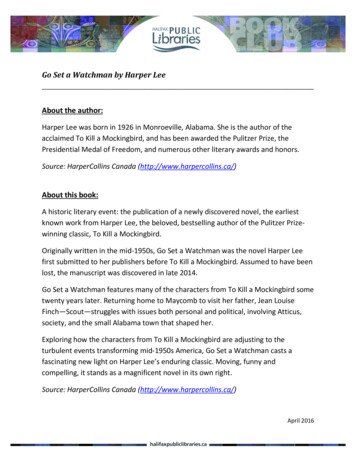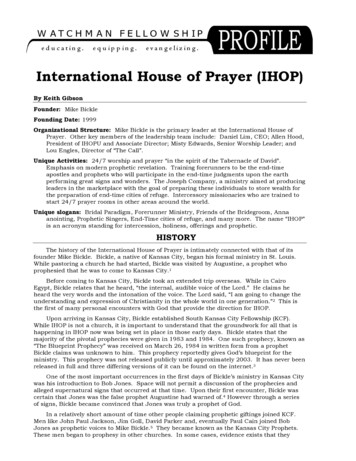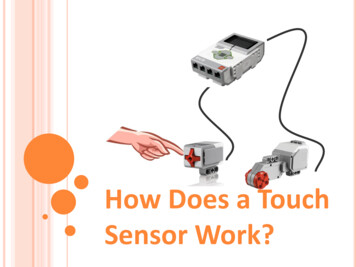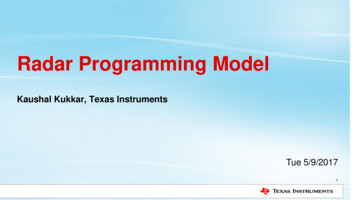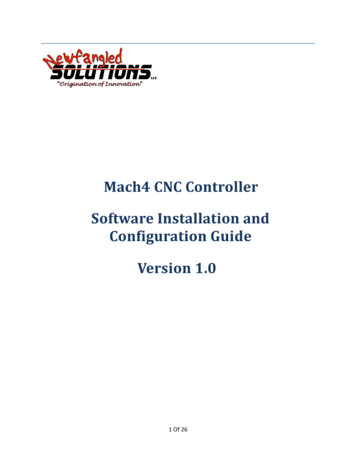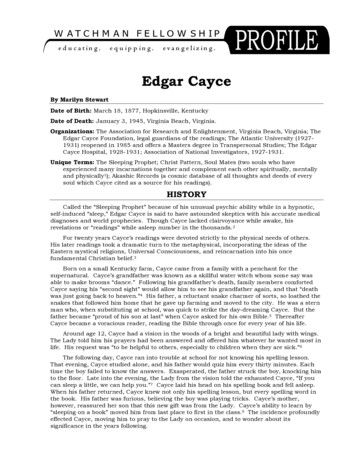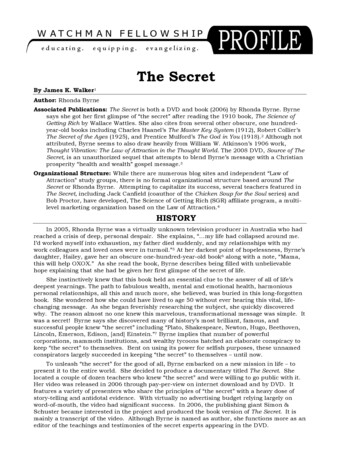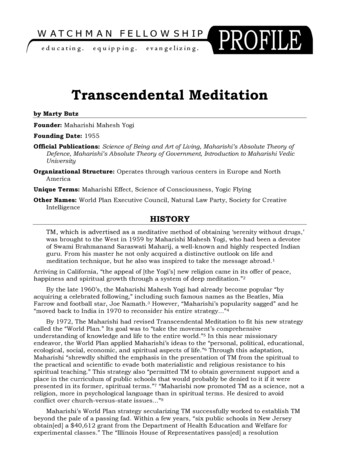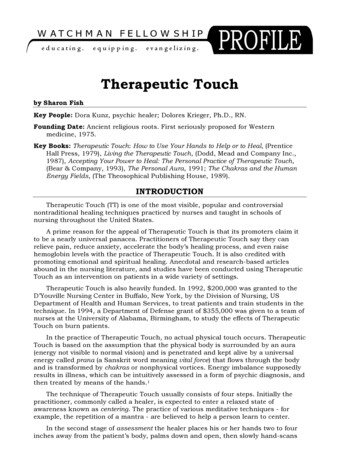
Transcription
Therapeutic Touchby Sharon FishKey People: Dora Kunz, psychic healer; Dolores Krieger, Ph.D., RN.Founding Date: Ancient religious roots. First seriously proposed for Westernmedicine, 1975.Key Books: Therapeutic Touch: How to Use Your Hands to Help or to Heal, (PrenticeHall Press, 1979), Living the Therapeutic Touch, (Dodd, Mead and Company Inc.,1987), Accepting Your Power to Heal: The Personal Practice of Therapeutic Touch,(Bear & Company, 1993), The Personal Aura, 1991; The Chakras and the HumanEnergy Fields, (The Theosophical Publishing House, 1989).INTRODUCTIONTherapeutic Touch (TT) is one of the most visible, popular and controversialnontraditional healing techniques practiced by nurses and taught in schools ofnursing throughout the United States.A prime reason for the appeal of Therapeutic Touch is that its promoters claim itto be a nearly universal panacea. Practitioners of Therapeutic Touch say they canrelieve pain, reduce anxiety, accelerate the body’s healing process, and even raisehemoglobin levels with the practice of Therapeutic Touch. It is also credited withpromoting emotional and spiritual healing. Anecdotal and research-based articlesabound in the nursing literature, and studies have been conducted using TherapeuticTouch as an intervention on patients in a wide variety of settings.Therapeutic Touch is also heavily funded. In 1992, 200,000 was granted to theD’Youville Nursing Center in Buffalo, New York, by the Division of Nursing, USDepartment of Health and Human Services, to treat patients and train students in thetechnique. In 1994, a Department of Defense grant of 355,000 was given to a team ofnurses at the University of Alabama, Birmingham, to study the effects of TherapeuticTouch on burn patients.In the practice of Therapeutic Touch, no actual physical touch occurs. TherapeuticTouch is based on the assumption that the physical body is surrounded by an aura(energy not visible to normal vision) and is penetrated and kept alive by a universalenergy called prana (a Sanskrit word meaning vital force) that flows through the bodyand is transformed by chakras or nonphysical vortices. Energy imbalance supposedlyresults in illness, which can be intuitively assessed in a form of psychic diagnosis, andthen treated by means of the hands.1The technique of Therapeutic Touch usually consists of four steps. Initially thepractitioner, commonly called a healer, is expected to enter a relaxed state ofawareness known as centering. The practice of various meditative techniques - forexample, the repetition of a mantra - are believed to help a person learn to center.In the second stage of assessment the healer places his or her hands two to fourinches away from the patient’s body, palms down and open, then slowly hand-scans
THE BEST RESOURCE COLLECTION ON CULTS AND RELIGIONSThe Watchman Fellowship ProfileNotebook provides you with an extensive personal library of information about cults, new and alternative religions, world religions, andreligious leaders. You will have atyour fingertips over twenty years ofresearch to answer your questions,strengthen your faith, and improveyour witness to others. Over 100 ProfilesOver 400 pages of informationThe history and primary teachings ofeach groupA Christian responseto deepen your faithand enhance your outreachClick here to order your copy of the watchman fellowship profile notebookBe sure to also order your free subscription to the Watchman Fellowship Profile. Several timeseach year you will receive a new, four-page Profile that you can add to your Profile Notebook, aswell as the latest news from Watchman Fellowship. Click here to order your free subscription!
Therapeutic Touch, page 2the entire body from head to toe in a synchronized fashion, intuitively searching forany imbalances in the person’s energy field. Areas of pain and accumulated tension orinflammation are thought to manifest as sensations such as tingling, unusualpressure or pulsation, and temperature changes that can be perceived through thehealer’s hands.Unruffling is the third step. The healer’s hands now engage in circular sweepingmotions designed to decongest accumulated energy, distributing any excess energy toareas of low flow or sometimes removing energy altogether by sweeping it down andout through the patient’s feet. The healers will usually flick their wrists or shake theirhands vigorously to rid themselves of any excess or negative energy.The healer’s hands will hover over certain parts of the body previously assessed asimbalanced in a step called modulation. Interpretations of this step vary. Some nursesview themselves as a channel of a universal healing energy that flows through themand out to their patients. Others believe they are somehow redirecting the patient’sown energies. Still others talk about transferring their own subtle energies to thepatient. A Therapeutic Touch intervention ends when the healer intuitively feels thepatient’s energies are back in balance.HISTORYDolores Krieger, then professor of nursing at New York University, formallyintroduced Therapeutic Touch to the nursing community in the May 1975 issue of TheAmerican Journal of Nursing,2 one of the most popular journals for practicing nurses.Krieger’s own research measured hemoglobin levels in persons who receivedTherapeutic Touch.She was influenced by Bernard Grad, a Canadian biochemist who taught at McGillUniversity. Grad had conducted a variety of experiments, including one on the growthof barley seeds watered from flasks held by Oskar Estebany, a well-knownshamanistic healer.3Though Therapeutic Touch has been enthusiastically embraced by thousands, itsresearch claims have been called into question because of flawed and uncontrolledstudies and lack of empirical evidence supporting the existence of an energy field.4In some states legal issues are being raised about a violation of patients’ rightsand issues of truth-in-advertising as Therapeutic Touch is generally presented to thepatient as an intervention supported by the principles of quantum mechanics(physics) and relativity. Robert Park, a physicist and spokesman for the AmericanPhysical Society, the country’s largest association of physicists, disagrees.In The Philadelphia Inquirer, Park was quoted as stating that Therapeutic Touchproponents who claimed that a human energy field could be explained by quantummechanics and relativity had “no idea what science is all about . . . they invoke thesymbols of science to justify themselves.”5DOCTRINEDescribed by Krieger as a nontraditional healing technique with no specificreligious context, Therapeutic Touch’s religious roots are highly syncretistic.Therapeutic Touch can best be categorized as an occult healing practice that isconceptually grounded in an eclectic mix of non-Christian religions and philosophies.Dolores Krieger is the person who has popularized Therapeutic Touch for nursesand the general public. Krieger’s mentor was Dora van Gelder Kunz, a clairvoyant and
Therapeutic Touch, page 3psychic healer. Krieger describes Kunz as a woman “born with a unique ability toperceive subtle energies around living beings.”6 Kunz writes that at birth she wascompletely enveloped in a caul (the fetal membrane) which she understood to signifysecond sight. She became aware of her clairvoyant abilities and began to develop themat the age of six or seven. Her tutor in the process was C. W. Leadbeater, acontroversial leader in the Theosophical movement in India.7 Kunz was also pastpresident of the Theosophical Society in America, Chairman of the TheosophicalPublishing House, and Editor-in-Chief of The American Theosophist.The primary training site for Therapeutic Touch intensive workshops is PumpkinHollow, a retreat center in Craryville, New York, owned and operated by theTheosophical Society of America. The roots of modern Theosophy can be traced toHelena Petrovna Blavatsky, a Russian-born psychic whose writings have paved theway for Americans’ current fascination with the paranormal.Theosophy is a syncretistic blending of ancient and occult religions andphilosophies including (but not confined to) concepts from Hinduism, Buddhism,Taoismm, the Egyptian Hermetic traditions, Neoplatonism, Kabbalism (Jewishmysticism), Rosicrucianism, Freemasonry and spiritualism. One major goal of TheTheosophical Society, founded in 1875, continues to be “the investigation of theunexplained laws of nature and the psychical powers latent in man.”8While Therapeutic Touch is most closely associated with Theosophical thoughtand various forms of eastern mysticism, it is also related to several other traditionsthat have their roots in occultism and esoterism.9One program at the American Nurses’ Association’s annual convention in 1994included a seminar entitled “Crones, Nurses and Witches.” The course was designed toexplore the concept of energy fields and their relationship to Therapeutic Touch.Stewart Farrar’s book, What Witches Do and Buckland’s Complete Book of Witchcraft10contain descriptions of a Wiccan or neopagan healing ritual that are nearly identical tothe Therapeutic Touch process described by Krieger; in Wiccan healing, the diagnosisis described as a clairvoyant art.Therapeutic Touch has also been compared to mesmerism, a 19th centurymagnetic healing practice. Founder Anton Mesmer believed that a subtle fluid (cf.“subtle energies”) in the body needed to be controlled or expelled from the body inorder for healing to occur. He believed the hands could be the vehicle for control orexpulsion. Disciples of Mesmer soon incorporated trance mediumship into thetechnique, paving the way for the development of spiritualism.11 In similar fashion,Therapeutic Touch has paved the way for various forms of mediumistic activity byspawning a number of evolutionary offshoots. Most notable is the practice of HealingTouch, an occult practice that teaches nurses how to contact spirit guides to aid inpsychic diagnosis and treatment. Healing Touch workshop content often incorporatesmaterial channeled by “ascended Masters.”12Krieger encourages students of Therapeutic Touch to tap into their unconsciousby Jungian types of dream interpretation, the drawing and visualization of mandalas,and divination by means of consulting the I Ching.13The development of latent telepathic abilities are expected byproducts of practicingTherapeutic Touch. Dowsing rods are also used in training to assess energy fields.14Barbara Blattner, RN, who describes Therapeutic Touch as a form of psychic healingin a textbook for nursing students, wrote that “occult sciences” like astrology,
Therapeutic Touch, page 4numerology, tarot, chirognomy (palm reading) and graphology (handwriting analysis)could also be used by nurses to develop their intuitive assessment skills for use inpsychic healing techniques like Therapeutic Touch.15CHRISTIAN RESPONSEAll forms of divination or occult assessment are strictly forbidden in the scriptures(Deuteronomy 18:9-12). Magical practices and divination are considered the work ofSatan and his powers (Acts 8, 13, 16 and 19).While Therapeutic Touch is often likened to the biblical tradition of the laying-onof hands, it is, in reality, much different. The underlying worldview of TherapeuticTouch is pantheistic in nature, characterized by the belief in energy as ultimate realityand an “essential unity among all beings.”16God as revealed in the scriptures and in the person of Jesus Christ is not a vagueimpersonal energy force. God is highly personal and distinct from (yet intimatelyinvolved with) His creation. In the biblical understanding of divine healing, Christiansare to lay hands - in a literal bodily sense - on the sick and pray for physical healing inJesus’ name. Spiritual and emotional healing can only occur in the context of apersonal relationship with the living God, not through “rebalancing energy.”RECOMMENDED READINGPowers of Darkness by Clinton E. Arnold, InterVarsity Press, 1992 givesperspective on the current occult explosion through an examination of biblicalteachings about magic, sorcery and divination. Bibliography, index, notes, paper, 244pages.The Death of Truth edited by Dennis McCallum. Excellent volume on the causesand impact of society’s belief that truth can not be known. Includes a chapter onTherapeutic Touch and postmodernism by Donal O’Mathuna. Glossary, index, paper,288 pages.Testing the Spirits by Elizabeth L. Hillstrom, InterVarsity Press, 1995. Excellentchapters on alternative healing in the context of the new mysticism. End notes, paper,240 pages.NotesThe Personal Aura, 32-55.784-7.3 Spiritual Dimensions of Healing: from Native Shamanism to Contemporary Health Care, 1992.4 See “Our Naked Emperor” editorial in Research in Nursing and Health, 1995, Vol. 18, 1-2.5 “Therapeutic Touch? Skeptics Here Bet Against It,” January 21, 1997, A1, A6.6 Therapeutic Touch, 4.7 The Personal Aura, 5-6.8 HPB, 1993, xviii.9 See “Therapeutic Touch: Healing Science or Psychic Midwife?”, Christian Research Journal, Summer, 1995, 28-38.10 Published 1983 and 1990 respectively.11 Mesmerism and the American Cure of Souls, 1982.12 Healing Touch workshop brochures on file.13 Therapeutic Touch, 80.14 Ibid., 71, 119.15 Holistic Nursing, 1981, 329, 331.16 Living the Therapeutic Touch, 33.12Profile is a regular publication of Watchman Fellowship, Inc. Readers are encouraged to begin their ownreligious research notebooks using these articles. Profiles are published by Watchman Fellowshipapproximately 6 times per year, covering subjects such as new religious movements, counterfeitChristianity, the occult, New Age Spirituality, and related doctrines and practices. Complete ProfileNotebooks containing all Profiles published to date are available. Please contact Watchman Fellowshipfor current pricing and availability. All rights reserved 1997.
Therapeutic Touch by Sharon Fish Key People: Dora Kunz, psychic healer; Dolores Krieger, Ph.D., RN. Founding Date: Ancient religious roots. First seriously proposed for Western medicine, 1975. Key Books: Therapeutic Touch: How to Use Your Hands to Help or to Heal, (Prentice Hall Press, 1979), Living the Therapeutic Touch, (Dodd, Mead and Company Inc.,
